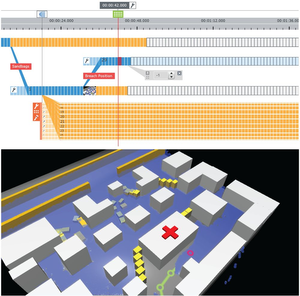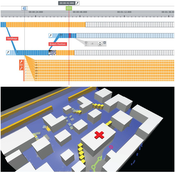Information
- Publication Type: PhD-Thesis
- Workgroup(s)/Project(s):
- Date: May 2011
- Date (Start): October 2008
- Date (End): June 2011
- TU Wien Library:
- 1st Reviewer: Eduard Gröller

- 2nd Reviewer: Günter Blöschl
- Rigorosum: 15. June 2011
- First Supervisor: Eduard Gröller

- Keywords: CFD, Data-Flow, Simulation Steering, Comparative Visual Analysis, Multiple Simulation Runs, Problem Solving Environment, Hypothesis Generation, Uncertainty, Flood Management
Abstract
Computer simulation has become an ubiquitous tool to investigate
the nature of systems. When steering a simulation, users modify parameters
to study their impact on the simulation outcome. The ability to test
alternative options provides the basis for interactive decision making. Increasingly
complex simulations are characterized by an intricate interplay
of many heterogeneous input and output parameters. A steering concept
that combines simulation and visualization within a single, comprehensive
system is largely missing. This thesis targets the basic components
of a novel integrated steering system called Visdom to support the user
in the decision making process. The proposed techniques enable users
to examine alternative scenarios without the need for special simulation
expertise. To accomplish this, we propose World Lines as a management
strategy for multiple, related simulation runs. In a dedicated view, users
create and navigate through many simulation runs. New decisions are
included through the concept of branching. To account for uncertain
knowledge about the input parameters, we provide the ability to cover
full parameter distributions. Via multiple cursors, users navigate a system
of multiple linked views through time and alternative scenarios. In this
way, the system supports comparative visual analysis of many simulation
runs. Since the steering process generates a huge amount of information,
we employ the machine to support the user in the search for explanations
inside the computed data. Visdom is built on top of a data-flow network
to provide a high level of modularity. A decoupled meta-flow is in charge
of transmitting parameter changes from World Lines to the affected dataflow
nodes. To direct the user attention to the most relevant parts, we
provide dynamic visualization inside the flow diagram. The usefulness of
the presented approach is substantiated through case studies in the field
of flood management. The Visdom application enables the design of a
breach closure by dropping sandbags in a virtual environment.
Additional Files and Images
Additional images and videos
Additional files
Weblinks
No further information available.
BibTeX
@phdthesis{waser_2011_VSD,
title = "Visual Steering to Support Decision Making in Visdom",
author = "J\"{u}rgen Waser",
year = "2011",
abstract = "Computer simulation has become an ubiquitous tool to
investigate the nature of systems. When steering a
simulation, users modify parameters to study their impact on
the simulation outcome. The ability to test alternative
options provides the basis for interactive decision making.
Increasingly complex simulations are characterized by an
intricate interplay of many heterogeneous input and output
parameters. A steering concept that combines simulation and
visualization within a single, comprehensive system is
largely missing. This thesis targets the basic components of
a novel integrated steering system called Visdom to support
the user in the decision making process. The proposed
techniques enable users to examine alternative scenarios
without the need for special simulation expertise. To
accomplish this, we propose World Lines as a management
strategy for multiple, related simulation runs. In a
dedicated view, users create and navigate through many
simulation runs. New decisions are included through the
concept of branching. To account for uncertain knowledge
about the input parameters, we provide the ability to cover
full parameter distributions. Via multiple cursors, users
navigate a system of multiple linked views through time and
alternative scenarios. In this way, the system supports
comparative visual analysis of many simulation runs. Since
the steering process generates a huge amount of information,
we employ the machine to support the user in the search for
explanations inside the computed data. Visdom is built on
top of a data-flow network to provide a high level of
modularity. A decoupled meta-flow is in charge of
transmitting parameter changes from World Lines to the
affected dataflow nodes. To direct the user attention to the
most relevant parts, we provide dynamic visualization inside
the flow diagram. The usefulness of the presented approach
is substantiated through case studies in the field of flood
management. The Visdom application enables the design of a
breach closure by dropping sandbags in a virtual
environment.",
month = may,
address = "Favoritenstrasse 9-11/E193-02, A-1040 Vienna, Austria",
school = "Institute of Computer Graphics and Algorithms, Vienna
University of Technology ",
keywords = "CFD, Data-Flow, Simulation Steering, Comparative Visual
Analysis, Multiple Simulation Runs, Problem Solving
Environment, Hypothesis Generation, Uncertainty, Flood
Management",
URL = "https://www.cg.tuwien.ac.at/research/publications/2011/waser_2011_VSD/",
}


 Thesis
Thesis
